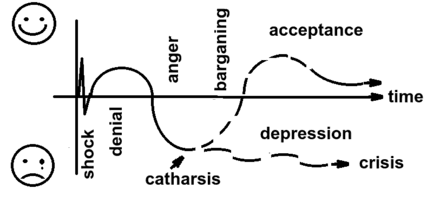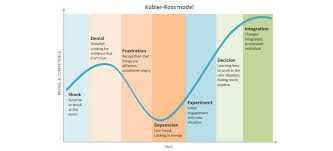Kubler ross
Change is an inevitable part and truth of life, and there is no running away from it. If change is well planned and formulated, it can produce positive results but even in spite of planning, change is hard to incorporate, accept and appreciate.
The Kubler-Ross Change Curve which is also known as the 5 stages of grief is a model consisting of the various levels or stages of emotions which are experienced by a person who is soon going to approach death or is a survivor of an intimate death. The 5 stages included in this model are denial, anger, bargaining, depression and acceptance. This model was introduced by and is named after Elisabeth Kubler-Ross in a book called ‘Death and Dying’ which came out in the year 1969. This book, as well as the model, was inspired by her association and work with patients who were terminally ill. The psychiatrist Kubler-Ross got inclined towards this subject because of lack of research and information on the subject of death and experience of dying. She began her research by analyzing and evaluating those who were faced with death, but the examination took the form of a series of seminars and then patient interviews, etc. later on.
- Denial : The Stage of shock or denial is usually the first stage in the Kubler-Ross Model and is mostly short-lived. This is a phase during which one puts on a temporary defense mechanism and takes time to process certain disturbing news or reality. One may not want to believe what is happening and that it is happening to him/her. It can bring about a dip in productivity and the ability to think and act. After the initial shock subsides, one may experience denial and may remain focused on the past. Some people tend to remain in the state of denial for a long time and may lose touch with reality.
- Anger : When the realization finally hits, and one understands the gravity of the situation, he/she may become angry and may look for someone to blame. Anger can be manifested or expressed in many ways. While some take out the anger on themselves, others may direct it towards others around them. While some may be angry at life in general, others may blame the economy. One always tends to remain irritable, frustrated and short tempered during this stage.
- Bargaining : When the stage of anger passes away, one may start thinking about ways to postpone the inevitable and try to find out the best thing left in the situation. Those who are not faced by death but by another trauma may try to negotiate in the situation and come to a point of compromise. Bargaining may help to come to a sustainable solution and might bring some relief to those who are moving close to what they wish to avoid altogether. The search for a different outcome or a less traumatic one may remain on during this stage.
- Depression : Depression is a stage in which the person tends to feel sadness, fear, regret, guilt and other negative emotions. He/she may have completely given up by now and may now reach a dead end from where the road only seems dark. One may display signs or indifference, reclusiveness, pushing others away and zero excitement towards anything in life. This may seem like a lowest point in life with no way ahead. Some common signs of depression include sadness, low energy, feeling demotivated, losing trust in god, etc.
- Acceptance : When people realize that fighting the change that is coming into their life is not going to make the grief go away, they resign to the situation and accept it completely. The resigned attitude may not be a happy space but is one in which the person may stop resisting change and move ahead with it.
1
3 reads
The idea is part of this collection:
Learn more about corporateculture with this collection
Why happiness is the ultimate goal
The importance of creating value
How to create wealth in the modern era
Related collections
Similar ideas to Kubler ross
The Kübler-Ross Model of Grieving
Grief comes in many forms and everyone has experienced it in many different ways, but this model theory is only a reference, not a rule. The five stages of grief are:
- Denial
- Anger
- Bargaining
- Depression
- Acceptance.
The Kubler-Ross Model
The Kubler-Ross Model, also known as the five stages of grief, consists of the various levels of emotions that are experienced when facing trauma. The five stages are denial, anger, bargaining, depression, and acceptance.
After the model was widely accepted, it was found to be valid...
The 5 Stages of Grief model.
One example of such integration is the 5 Stages of Grief model. While it might be not a universal one, it turns out that these stages map beautifully into fear responses:
- Denial → flight
- Anger → fight
- Barg...
Read & Learn
20x Faster
without
deepstash
with
deepstash
with
deepstash
Personalized microlearning
—
100+ Learning Journeys
—
Access to 200,000+ ideas
—
Access to the mobile app
—
Unlimited idea saving
—
—
Unlimited history
—
—
Unlimited listening to ideas
—
—
Downloading & offline access
—
—
Supercharge your mind with one idea per day
Enter your email and spend 1 minute every day to learn something new.
I agree to receive email updates



